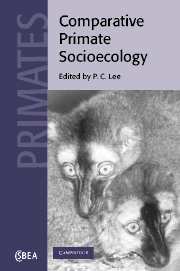Book contents
- Frontmatter
- Contents
- List of contributors
- Preface
- Part 1 Comparative methods
- Part 2 Comparative life history and biology
- Part 3 Comparative socioecology and social evolution
- 10 Lemur social structure and convergence in primate socioecology
- 11 Why is female kin bonding so rare? Comparative sociality of neotropical primates
- 12 Energetics, time budgets and group size
- 13 Ecology of sex differences in great ape foraging
- 14 Hominid behavioural evolution: missing links in comparative primate socioecology
- 15 Evolutionary ecology and cross-cultural comparison: the case of matrilineal descent in sub-Saharan Africa
- Editor's conclusion: Socioecology and social evolution
- Index
11 - Why is female kin bonding so rare? Comparative sociality of neotropical primates
Published online by Cambridge University Press: 24 August 2009
- Frontmatter
- Contents
- List of contributors
- Preface
- Part 1 Comparative methods
- Part 2 Comparative life history and biology
- Part 3 Comparative socioecology and social evolution
- 10 Lemur social structure and convergence in primate socioecology
- 11 Why is female kin bonding so rare? Comparative sociality of neotropical primates
- 12 Energetics, time budgets and group size
- 13 Ecology of sex differences in great ape foraging
- 14 Hominid behavioural evolution: missing links in comparative primate socioecology
- 15 Evolutionary ecology and cross-cultural comparison: the case of matrilineal descent in sub-Saharan Africa
- Editor's conclusion: Socioecology and social evolution
- Index
Summary
Introduction
Some female primates remain in their natal groups for life. Female kin in these cohesive, matrilineal groups form affiliative bonds that are expressed through proximity, grooming, and agonistic support against members of other matrilines and unrelated males. Kin-bonded females generally play key roles in determining group movements, defending resources during intergroup encounters, and repelling or assisting extra-group males in their attempts to immigrate or oust resident males from positions in the group (Wrangham, 1980). Male-biased dispersal often, but not always, covaries with the occurrence of female kin bonding, contributing to the avoidance of inbreeding and corresponding to the lower levels of nepotism among males in multi-male groups (Moore, 1984; Pusey and Packer, 1987).
The prevalence of female kin bonding and male-biased dispersal among many of the best studied Old World monkeys has fuelled an enduring myth in which primates with different dispersal and social systems were treated as deviant exceptions to this otherwise ‘typical’ primate pattern (Moore, 1984; Strier, 1994a). Long-term studies on a greater diversity of primate taxa have since shifted this perspective, however, and now the distribution of female kin bonding and male-biased dispersal across primates is more appropriately recognised as a reflection of phylogenetic or ecological affinities instead of a universal standard against which all interspecific and intraspecific variability is compared (Moore, 1992). Thus, female kin bonding with male-biased dispersal among Strepsirhines can be seen as consistent with a primitive mammalian condition, whereas the absence of female kin bonding among extant hominoids can be considered a derived condition, reflecting both their monophyletic antiquity (Lee, 1994) and the relaxation of predation pressures on these large-bodied primates.
- Type
- Chapter
- Information
- Comparative Primate Socioecology , pp. 300 - 319Publisher: Cambridge University PressPrint publication year: 1999
- 20
- Cited by



